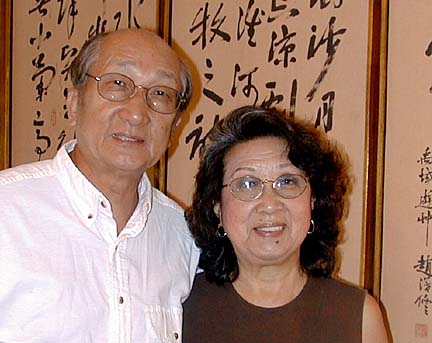


HILO >> In the opening years of the 1900s, a little girl from the Kan family in northern China refused to deform her feet by binding them. Asian epic family
odyssey ends in HiloARTISTIC ENDEAVORS
Rod Thompson / rthompson@starbulletin.com
The rebellious girl, Kan Gechen, went on to graduate from a women's gymnastics college and married a dashing military man who became a diplomat in Japan and a general in Manchuria, but was on the losing side in World War II.
Gechen, now a mother, escaped to Taiwan with her daughter Lee Meng-Chin.
Another who found refuge in Taiwan was Chao Tse-Hsiu, the college-age son of a merchant and former magistrate in Qingdao.
When Lee and Chao, sharing artistic interests, married in the Catholic Church, they used Christian names.
When they immigrated with their four children to the Big Island in 1969, those names became famous, artists Linus and Jane Chao.

Jane paints in a realistic, "disciplined brush" style, she says. Linus does that and the "free hand" and "no bones" styles, creating misty glimpses of mountain scenery, for example. An indicator of their success is the Hilo doctor who bought more than 35 of Linus' works.Success was hardly assured for these two from a war-torn country. The fall was hardest for Jane's once-rebellious mother.
The niece of a warlord called "Big Knife" in Japanese-controlled Manchuria, she married one of her uncle's officers.
Although multiple wives were commonplace for wealthy men, Jane's mother was distraught when she learned her husband had another wife. She withdrew emotionally, leaving Jane to an artistic education, but a lonely childhood in Japan and Manchuria.
At the end of the war, Jane's father, now a general and a Japanese collaborator, was taken away by the Russians. Her mother, with IOU's sewn into her shoes, escaped to the south with Jane.

Meanwhile, schoolboy Linus was winning art prizes in Qingdao. With Communists taking over after the war, his father sent him to college in Taiwan, expecting Communist power to blow over in a few years. Linus wasn't able to return until 1976. His mother and father had died."It's a tragedy for a young man to leave his family and his country," Linus said.
In Taiwan, the young couple struggled while Linus did military service. "All my wedding gifts went to the pawn shop," Jane said.
Later, making educational movies, Linus came to the attention of a Jesuit priest, Philip Bourret, who sent him to America to learn animation.
After three months at Walt Disney Studios and 112 years at Hanna-Barbera, Linus went home to become "the father of Taiwanese animation."
"My wife never had a diamond ring," Linus said. "If I had money for a diamond, we would rather have (animation) equipment."
When political unrest threatened Taiwan, Linus wanted to move the family to Los Angeles. Jane insisted on the Big Island, where a friend lived.
Their third child, Mary, remembers their plane circling over Honolulu as they reached their new country. She remembers her mother saying, "Now you're going to a new culture. Now you take the best of both."
Mary didn't know what "culture" meant.
The oldest child, Grace, knew from American television programs "that America was a land of Caucasians."
She was befuddled when her mother took her to Hilo Intermediate School, not speaking a word of English, and she couldn't see a single Caucasian face in the class.
"I grew up (in Taiwan) thinking America is Lucille Ball and 'Leave It to Beaver,'" she said.
Mary was surprised by the absence of school uniforms and the apparent lack of classroom discipline.
The smallness of Hilo provided security, while the experiences of their parents provided a broad outlook, Mary said. "It was a very rich culture in our family. They made the world small for us."
A computer programmer, Mary married a Norwegian and lived in Sweden for eight years.
Her middle sister Ann -- who announced as a child in Taiwan, "I'm going to be a doctor some day" -- married a Belgian and spent 4 12 years in Rwanda doing pre-natal AIDS research.
The youngest child, Peter, an electronics engineer, is "happily unmarried" and selling computer systems in Santa Monica, Calif.
Grace married a Japanese-Hawaiian man and taught ballet. Then, in a move she finds not at all strange, she switched to teaching math. "Space and numbers, that's what dance is," she said.
She is the one who has turned her focus back to the Chinese origins of the family, researching her genealogy.
And she is the one writing a book about her grandmother, the stubborn girl who refused to bind her feet, the liberated woman, before her marriage to the general, who once renamed herself Revolutionizing Earth.